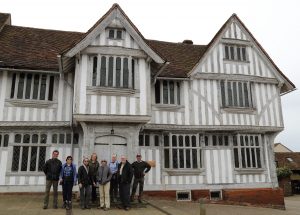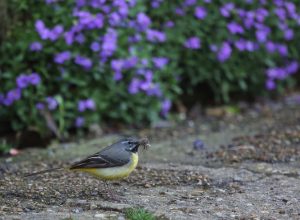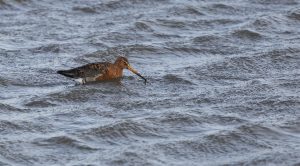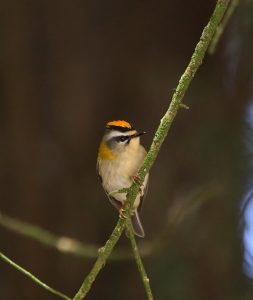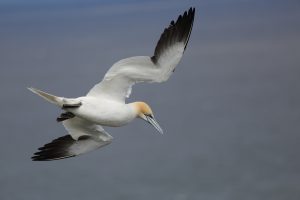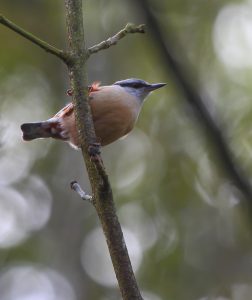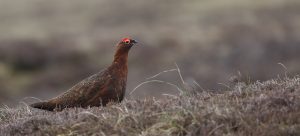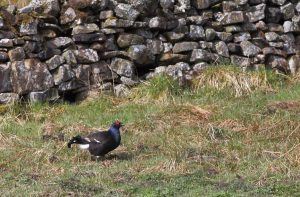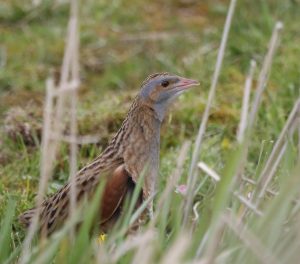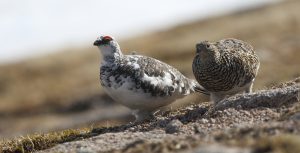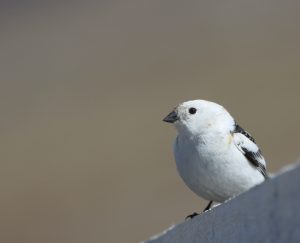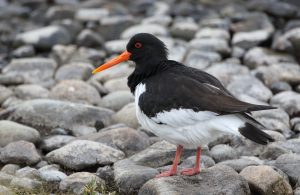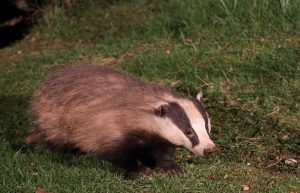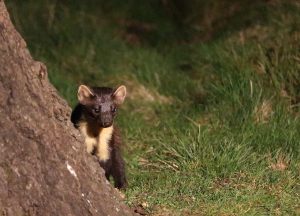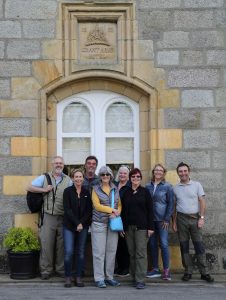On the way north from Heathrow to Saxmundham in Suffolk, we stopped off at Sutton Hoo, a regal Anglo-Saxon burial site, under a sunny blue sky at 25°C, with a nice show of Daffodils and Bluebells, where early birds included Mistle and Song Thrushes, Blackbird, Blue and Great Tits, Goldfinch, a very obliging Chaffinch in full song, a not so obliging yaffling Green Woodpecker and plenty of Pied Wagtails. Further north at Sizewell Beach, the target Black Redstart was nowhere to be seen but offshore there were lots of Kittiwakes, plus Herring, Black-headed, Great Black-backed and Lesser Black-backed Gulls.
With news of a Turtle Dove seen yesterday on Westleton Heath, we started off there today, but there was no sign of the dove, although a fly-by by two Red Kites was a good consolation, shortly followed by a couple of Woodlarks and a Kestrel hovering close by on the stiff breeze. The breeze was not conducive to an appearance by our target Dartford Warbler, but eventually we found our quarry when a smart male broke cover and repeatedly perched obligingly for a nice view in the scope, while singing his scratchy song. A pair of Stonechats also showed very well here. Where the heath meets the adjacent woods, we also found a scarce Marsh Tit, followed by great views of a Stone Curlew, with its large yellow eyes, loitering on the short turf, closely cropped by the many Rabbits which thrive here. It was midday by the time we arrived at the Minsmere reserve, where the mature Oak wood soon produced a couple of Treecreepers, and a singing Blackcap, while at least five Marsh Harriers were on patrol over the extensive reedbeds, with the occasional ‘boom’ of a well concealed Bittern bellowing out from deep within the reeds. Meanwhile the scrapes were jam-packed with birds, including Shelduck, Redshank, Oystercatcher, rusty-necked Black-tailed Godwits, loads of Avocets, a solitary Brent Goose and Spoonbill, as well as numerous Sandwich and Common Terns, and quite a few smart Mediterranean Gulls amongst hundreds of Black-headed Gulls, and we even found a rare second year Caspian Gull, amid the crowd, with a diagnostic clean white head and long slender bill, thanks to Suzie’s photographic skills. Meanwhile, Swallows and Sand Martins swarmed above the lagoons, and we found Linnets and a handsome male Wheatear along the coastal path, making a total of 62 species seen today.
Heading northwest from Saxmundham we began today with a visit to the picture postcard village of Lavenham, a cluster of fifteenth century half-timbered houses, residing at a variety of crooked angles, with an imposing ‘wool church’ opened in 1525. The nearby Lackford Lakes nature reserve produced Egyptian Geese, Common Sandpiper, Little Ringed Plover, another Marsh Tit, a calling Cuckoo and a singing Nightingale, which remained deep in the scrub. Moving on to Lakenheath Fen, Goldfinches and Reed Buntings showed well on the bird table right outside the Visitor Centre, while the soundscape included Cetti’s Warbler, Sedge Warbler, numerous Reed Warblers and an occasional booming Bittern. Along the trails here we also heard Bearded Tits, and eventually two stunning males and a female showed really well at close range, quickly followed by a Bittern breaking cover from the adjacent reeds and flying for several hundred yards; the best Bittern fly-by I had ever seen!
We started the new day with a pair of Grey Wagtails delivering insects by the beak full to their nest in a hanging basket right outside our lodge! Passing through picturesque Norfolk villages of knapped flint houses, the hedgerows produced Yellowhammer and a remarkably close view of a Lesser Whitethroat, just a few yards away, with numerous Skylarks singing over the fields. Nearby Cley Marsh was alive with birds including plenty of Shelduck and Avocets, and vociferous but well hidden Reed Warblers, plus Great White Egret, Heron, Brent Goose, Wigeon, Black- and Bar-tailed Godwits, Knot, Dunlin, Curlew, my first Swifts of the year and a smart male Ruff, with a blackening back and a developing black ruff, while a Brown Hare showed really well right in front of one of the hides. Moving west along the coast to Titchwell Marsh, we saw hundreds of noisy Sandwich Terns, Black-headed and Mediterranean Gulls, and plenty more Black-tailed Godwits, looking resplendent in their rich rusty breeding plumage, along with Pochard, Greylags with cuddly little yellow goslings, a lone Pink-footed Goose, a large raft of Common Scoters offshore, and another smart male Ruff, this time with a rich ginger back and a developing ruff to match, snatching the ‘Bird of the Day’ award.
It was bright and breezy this morning as we headed west, calling first of all at Roydon Common where we soon found our target Woodlarks singing their lovely song, while several male Stonechats posed obligingly on the Heather, a couple of Kestrels hovered on the stiff breeze, and Lapwings performed their aerobatic display flights. We even found a group of eight Whimbrel, stopping off briefly here on their journey north. This afternoon we visited the Sandringham House estate, the Christmas retreat of Her Majesty the Queen, where the ancient woods are home to Green and Great Spotted Woodpeckers, dazzling Jays, and newly arrived Willow Warblers singing their distinctive descending tune, while the stunning little Firecrest is a car park bird here! Continuing our journey westward, we left Norfolk, via Cambridgeshire and Northamptonshire, arriving in Rutland, England’s smallest county, in time for a late afternoon visit to Lyddington, with its quaint golden stone thatched cottages, clustered around the village green and ancient church dedicated long ago to Saint Andrew.
In view of the miserable weather today, we decided to forego some birding in favour of a sightseeing visit to Newark-on-Trent, where the English civil war began in 1642. After lunch in town, we soldiered on in the rain at nearby Langford Lowfields, seeing many of the usual wetland suspects, although the singing Reed Warblers remained ‘invisible’ and it was too wet even for Water Rails!
It was another grey wet morning and a disappointing 6°C as we headed north up the A1, through Robin Hood country and on into Yorkshire, England’s largest county, for a visit to the Potteric Carr nature reserve, where our main aim was to find the rare Black-necked Grebe. In the woods here we soon had good views of Treecreeper and a hammering Great Spotted Woodpecker, and despite the un-spring like weather, there were plenty of Swallows and both House and Sand Martins, hawking insects low over the open water, along with an early Swift. While having lunch in one of the hides, we were remarkably lucky to see yet another Bittern break cover and fly across the front of the hide at close range, before dropping without trace back into the reeds. Having seen plenty of Little and Great Crested Grebes on the reserve, we eventually found a pair of the much rarer Black-necked Grebe, showing off their yellow ear tufts and bright red eyes, but it wasn’t these, nor even the Bittern which won the ‘Bird of the Day’ accolade! On the way back to the Visitor Centre, we enjoyed prolonged fantastic close views of a Water Rail, turning over dead leaves in a shallow ditch alongside the track with its blood-red bill, while occasionally calling to a neighbour hidden within the marsh. By the time we reached the Parsonage, just south of York, it had stopped raining, and after a sumptuous meal, we headed out again to explore the grounds in the hope of finding a Tawny Owl. We were not disappointed, as the unmistakable hoot of a Tawny rang out from the churchyard next to the hotel, while still reasonably light, creating a rumpus amongst the local Blackbirds. Suddenly the owl flew silently over us and landed in a nearby leafless tree giving everyone a wonderfully clear view and bringing the trip list to 110 species seen so far.
There was a strange bright light up in the sky this morning as we headed east across Stamford Bridge, the site of a battle in 1066 where the Saxon king Harold Godwinson defeated Harald Hadrada, king of Norway. Journey’s end was the coast at Bempton Cliffs, with very close views of Tree Sparrows outside the Visitor Centre. Meanwhile, the cliffs were swarming with a quarter of a million seabirds! The spectacular scene was alive with Guillemots, Razorbills, Kittiwakes and gliding Gannets, and amongst the raucous throng were Puffins and Fulmars. On the way back, we made time for a spot of sightseeing around the imposing York cathedral, founded in 637 AD, and towering to a height of 236 feet! Back in the hotel grounds the sound of a squeaky wheel attracted us to a very showy Goldcrest, making a total of eight new birds seen today.
The Goldcrest showed again this morning, before we set off west into the Yorkshire Dales National Park for a visit to Bolton Priory, founded in the twelfth century by Augustinian monks, in a lovely setting beside the river Wharfe, where a pair of Goosanders were new for the trip list. Crossing the Pennines into the red rose county of Lancashire, a stroll alongside the burbling Pendle Water produced good views of Nuthatch and Siskin, but strangely no Dippers. After lunch in the café here we ascended Pendle Hill, spotting Lapwing, Meadow Pipit and a pair of Wheatears on the lower slopes. Continuing our journey in a north westerly direction, via the picturesque Forest of Bowland, we found Grey Wagtail, Lesser Redpoll, Red-legged Partridge, a Mistle Thrush on a nest, several Oystercatchers posing on the long stone walls and plenty of Pheasants, but still no Dippers! Meanwhile a pair of smart Pied Flycatchers were a real bonus. On the drive down from Bowland, the Irish Sea shimmered in the early evening sun, and we had now gone from east to west coasts in two days.
Today was May Day and it was sunny with a stiff cool breeze. On the way to the Leighton Moss RSPB reserve, a brief visit to Warton Crag produced a Peregrine soaring overhead. Our arrival at Leighton Moss, was greeted with plenty of Avocets, plus about 300 Black-tailed Godwits, 33 Bar-tailed Godwits and around 320 Knot developing their rusty red breeding plumage. Other good sightings here included Nuthatch, Bullfinch, Coal and Marsh Tits and handsome Pheasants at point blank range, a drake Scaup, two drake Wigeon, several male Marsh Harriers, a Stoat on the trail ahead of us, and a Red Deer hind cavorting and splashing in the shallow water in front of one of the hides. Moving on into the beautiful North Pennines we enjoyed fabulous roadside views of Curlews, Lapwings, Golden Plovers in black-bellied breeding plumage, numerous Red Grouse, including a stand off between two males with magnificent brilliant red inflated eye brows, and a Short-eared Owl hunting low over the moorland and then captured in the scope while eating its prey. Not far from our hotel, we decided to seek out the Black Grouse and soon found a group of twelve males in a rather subdued mood, hunkered down against the wind in the absence of any females. Meanwhile a Woodcock in the grass beside the road, which then flew across the road in front of us, was an added bonus, bringing the trip list to 133 species seen so far.
It was grey and miserable first thing this morning, but two dozen spectacular male Black Grouse squaring up to each other while puffing themselves up and flapping their wings as they fought to attract the attentions of a handful of judging hens, made for a colourful start to the day. While the Blackcocks squabbled over the hens, a Snipe called nearby and Curlews rang out their bubbling calls across the hillsides. After breakfast back at the hotel, we set out in search of a Dipper, and soon found one posing nicely in the scope along the banks of Harwood Beck, shortly followed by very lucky close views of another three Blackcocks, with the alpha male showing off really well right next to the road! From here it was a scenic drive north through the desolate North Pennines, still with traces of the most recent snowfall, and across the border into Scotland, in time to catch the 5pm ferry from Oban to the Isle of Mull, with Shag, Black Guillemot and Gannets on the crossing.
The forecast was too windy for our planned cruise to the Treshnish Isles, so we followed Plan B, on a mission to see the rare Corncrake on Iona. We were a little delayed en route by the appearance of at least five Great Northern Divers close in to the shores of Loch Scridain, along with a couple of Greenshanks, a Whimbrel and a road blocked by Highland cattle! Within ten minutes of landing on Iona, we homed in on the tell tale “crex crex” call, and soon had the notoriously secretive Corncrake calling its head off in a cottage garden, while repeatedly throwing its head back to project the harsh rasping call, as we watched through the scope in sheer amazement at a range of just twenty feet! This was the easiest Corncrake ever! What a jaw dropping experience. Imagine having Corncrake on your garden list. With time to spare we visited the Abbey, founded by Saint Columba in 563 AD, and then returned to the mainland hoping to find an Otter, but it was far too wet! However, a Whooper Swan, having a break on its way back to Iceland, was a nice bonus.
It was still too windy for the Treshnish Isles cruise, and so Plan C involved a circuitous exploration of Mull, beginning at Grass Point, where the lichen-encrusted woods produced good views of a singing Tree Pipit, whilst a singing Redstart remained hidden way back in the canopy. Next we followed a scenic route along the B8035, where new sightings included a male Whinchat, a couple of displaying Snipe, a ghostly grey male Hen Harrier and then a soggy-looking White-tailed Eagle hunkered down in its tree top nest. By lunchtime the drizzle had stopped, and as we sat beside Loch na Keal, having our lunch, a ‘flying barn door’ circled over the sea; it was of course, another White-tailed Eagle. There were also several Great Northern Divers offshore, while Rock Pipits darted around on the nearby rocky shore. This afternoon, the song of a Wood Warbler was a new sound for us, and we soon had superb views of this scarce smart warbler, with a lovely yellow breast and clean white underparts. A little further along the same road we had a White-tailed Eagle sitting majestically in a tree, not far from the road, so that its blonde head and large yellow bill showed up really well in the scope. Having scoured many miles of promising looking coastline for an elusive Otter we spotted two fishing close in, in the opposite direction to our view of the eagle. We now had time to visit the colourful waterfront at Tobermory, and sample the whisky in the local distillery, followed by handsome male Red-breasted Merganser and Eiders on the way ‘home’; a fitting way to end our time on ‘marvellous Mull’.
Back on the mainland we headed north on a scenic drive along the shore of Loch Linnhe to Fort William, in the shadow of snow-clad Ben Nevis, the highest point in the British Isles at 4406 feet above sea level, and then east along Glen Spean. It was a lovely sunny day at last, ideal for a picnic at the Creag Meagaidh National Nature Reserve, where the woods were alive with Chaffinches, Willow Warblers, Lesser Redpoll, Treecreeper and an unexpected singing Redwing! Further east, in the Spey valley, we scoped an Osprey sitting in its large stick-bundle nest, while nearby Avielochan produced several bright-eyed Goldeneyes, and after some searching, a couple of smart Slavonian Grebes, with resplendent golden ear tufts and sparkling red eyes, sitting quietly amongst the emergent vegetation in a secluded corner of the loch. Journey’s end was the wonderful Grant Arms Hotel, our last base of the tour, in Grantown-on-Spey, home of Clan Grant since 1765.
It was actually warm and sunny this morning, and 11°C at the foot of Cairn Gorm, as we togged up with multiple layers for an assault on the top, via the funicular railway, and on the ride up, we spotted a Ring Ouzel perched on a fence beside the track. From the top station, we had barely gone 100 yards, across a patch of melting snow, when Cindy spotted a movement just ahead of us, and we quickly realized it was a Ptarmigan! We had actually found a pair of these superbly camouflaged birds within minutes of setting off, and spent the next half an hour marveling at these intricately patterned birds as they quietly pecked at the ‘tundra’ within ten yards of us, while completely unperturbed by their audience. Both birds were still white below, with thickly feathered legs and feet, and the male had turned dappled grey above, to match the lichen covered rocks, whereas the female had developed a gorgeously intricate pattern of black and gold, to help her blend in with the dead grasses, once she was ready to sit on a nest; isn’t nature remarkable? During this magical half hour, a male Snow Bunting gate-crashed the party, by landing on a snow fence, even closer than the Ptarmigan, while singing, as if wanting to steal the limelight from the Ptarmigan! A scan of the hillside even revealed the white face of a Mountain Hare peeping out from behind a rock. Mission accomplished, we returned to the Ptarmigan Restaurant for a mid-morning drink and then descended via the funicular, passing the Ring Ouzel again on the way down! By now it was 20°C at the bottom and tee shirt weather, and it turned out to be by far the warmest day of the year so far. Meanwhile the scenery was magnificent.
This afternoon we visited the Loch Garten RSPB reserve, with its famous Osprey nest. Strolling through the beautifully tranquil Caledonian forest, we enjoyed super views of a smart male Redstart, and there were plenty of calling Siskins, but not a sniff of a Crested Tit or Red Squirrel.
This was our last full day ‘in the field’, so we began with ‘Operation Squirrel’, as it was such a popular target. Within ten minutes of leaving the hotel, we were watching two of these delightful creatures chasing each other up and down tree trunks, and scampering through the branches, while occasionally stopping to pose for pictures. Ten minutes later, we found our second target for these woods, with close views of a perky little Crested Tit. Job done, and it wasn’t even 9am yet! Further north at Lochindorb we had close roadside views of Wheatear, Oystercatchers and yet more Red Grouse, a close encounter with two Cuckoos in an aerial chase, as well as perched, and a distant view of a Black-throated Diver.
After the last of many excellent dinners on this tour, we headed south for the Speyside Wildlife hide near Loch an Eilean on the Rothiemurchus estate. As the daylight faded and the floodlights came on, tiny Wood Mice were first to appear, attracting the attentions of a nearby Tawny Owl. Right on cue at 10pm, the first Badger appeared, snuffling up peanuts with the efficiency of a Hoover, joined ten minutes later by a second Badger, and then a far more sleek Pine Marten, with the agility of a squirrel. An hour passed quickly as five Badgers, all came to forage bold as brass right outside the hide windows, giving face to face views! What a magical experience.
By now we had driven 1663 miles, through a variety of beautiful landscapes from the Suffolk coast to the Cairngorms, stayed at nine excellent hotels, eaten sixteen first class dinners, walked around 70 miles and seen 160 bird species including, in order of appearance, a diversity of star birds like Kittiwake, Stonechat, Red Kite, Dartford Warbler, Woodlark, Marsh Tit, Stone Curlew, Marsh Harrier, Avocet, Mediterranean and Caspian Gulls, Sandwich Tern, Spoonbill, Brent Goose, Wheatear, Little Ringed Plover, Bearded Tit, Bittern, Grey Wagtail, Lesser Whitethroat, Yellowhammer, Great White Egret, Ruff, Yellow Wagtail, Pink-footed Goose, Common Scoter, Whimbrel, Firecrest, Jay, Black-necked Grebe, Water Rail, Tawny Owl, Gannet, Guillemot, Razorbill, Puffin, Fulmar, Siskin, Lesser Redpoll, Pied Flycatcher, Peregrine, Raven, Scaup, Golden Plover, Red Grouse, Short-eared Owl, Black Grouse, Woodcock, Dipper, Hooded Crow, Black Guillemot, Great Northern Diver, Corncrake, Whooper Swan, Tree Pipit, Whinchat, Hen Harrier, White-tailed Eagle, Rock Pipit, Wood Warbler, Red-breasted Merganser, Eider, Redwing, Osprey, Goldeneye, Slavonian Grebe, Ring Ouzel, Ptarmigan, Snow Bunting, Redstart, Crested Tit, Cuckoo and Black-throated Diver, as well as fantastic views of Badger and Pine Marten, plus Otter, Stoat, Red Squirrel, Red, Roe and Muntjac Deer, Brown and Mountain Hares, and Common Seal. A special thanks to all involved for making this such an enjoyable trip.

